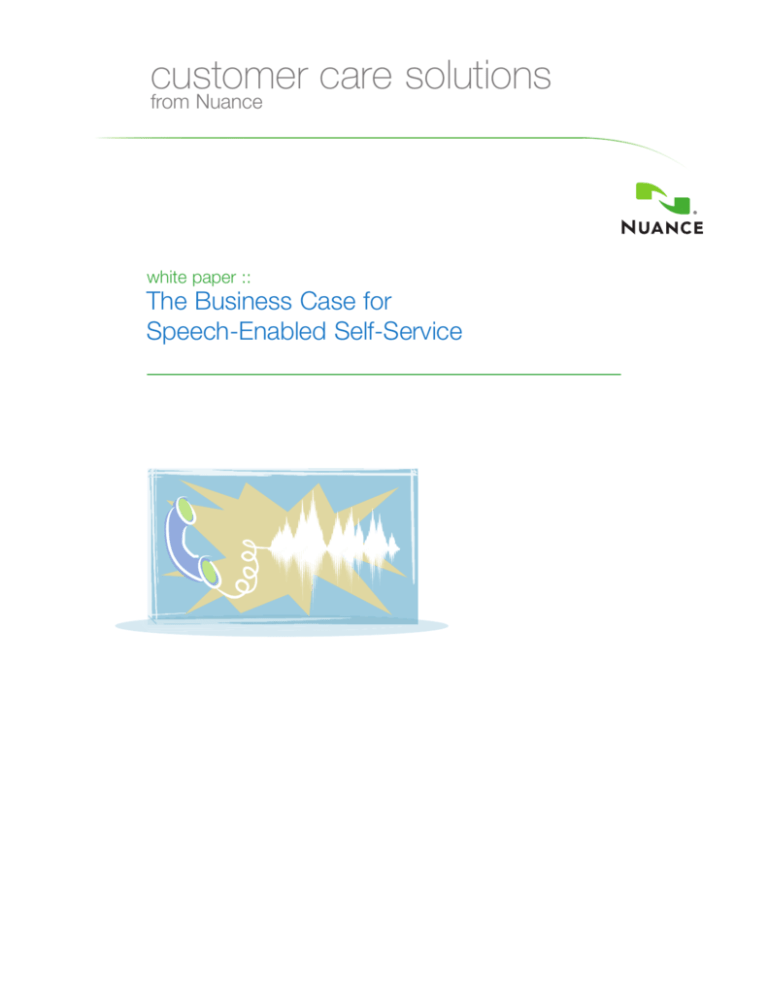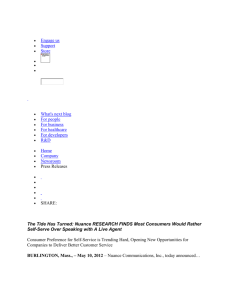
customer
care
solutions
from Nuance
white paper ::
The Business Case for
Speech-Enabled Self-Service
NUANCE :: customer care solutions
Introduction
Despite the noble goals of customer service to increase loyalty and revenue, driving costs out of the
organization remains a priority for businesses. Challenging economic times have intensified the need for call
center executives to find incremental savings in everything they do, without sacrificing the customer
experience. No business can afford to lose a customer right now – but balancing these two seemingly
competitive goals might seem impossible. But the fact is, a strong speech automated care operation can
deliver on both objectives simultaneously.
Skeptical? Over 71% of consumers surveyed prefer the 24x7x365 availability of automated interactions over
the voice channel.* At the same time, speech automation allows call centers to reduce transfer rates, agent
handling time and overall call time from the bottom line while improving customer loyalty and satisfaction. By
providing a means for consumers to help themselves, call centers stand to slash costs from their operating
budgets.
Top Reason Consumers
Prefer Automated Interactions
71%
Most consumers prefer using automated
interactions over the voice channel
because of 24x7x365 availability
2
Doing the Math
Imagine your company handles half a million calls per month, or six million calls per year. If a speech system
enables you to increase your automation rate by 5%, you’ll be capable of handling an additional 300,000 calls
per year. If you save $5 per call, that adds up to a $1.5 million annual savings. Furthermore, these figures
don’t even factor in the higher customer satisfaction rates, repeat usage and general goodwill that come from
presenting your callers with an intuitive interface to customer service.
Implementing speech technology can realize
savings by increasing automation rates.
5%
=
$1.5 Million
Savings
For example, consider a call center receiving 6 million calls per year
that raises its automation rate by 5% by implementing speech technology.
At a savings of $5 per call, the additional 300,000 calls handled
through the automated system provide $1.5 million in savings.
Take, for example, a leading U.S. bank that wanted to improve the effectiveness of its self-service system by
providing a more consistent, satisfying caller experience. First, the bank consolidated its 4000 different toll-free
numbers into one and routed callers based on recognizing their answers to the question “How can I help you?”
It then added speech automation for applications including call routing for credit card, lines of credit, mortgage
and loan, funds transfer and deposits. Within ten weeks, the application had achieved a 78.5% effectiveness
rate, a 2% increase over the effectiveness of the bank’s legacy touchtone applications. Ultimately this 2%
increase saved the bank over $15M annually.
In another example, one of the UK’s largest banks wanted to lead the market in offering superior customer
service while also maximizing productivity and reducing costs in its existing call centers. Over the course of
several years, it rolled out a series of speech-enabled self-service applications that eliminated the 40-45
seconds previously required for agents to answer calls, identify and verify customers. Call volume was
therefore reduced considerably as were operational costs. The benefit of savings for one speech application
alone was £4.2M annually – no small change. Importantly, with all the savings, the quality of care was actually
improved as a new single number for contact has made it easier for customers to contact the bank.
3
NUANCE :: customer care solutions
Consider also the efficiencies realized by a U.S. utility company. With 1.5 million customers spread across
multiple states, it was managing over 4.7 million calls per year. Its existing IVR was reaching end-of-life and
couldn’t be supported much longer. Completion rates in the IVR were a mere 32%. The utility needed to
implement new applications – applications that were not feasible through their existing touchtone system.
Using speech, the utility introduced a self-service system available 24 hours per day that asked “How may I
help you today?” This new system now handles interactions for a number of customer needs, including turn
on/turn off/transfer service requests, outage reporting, documentation requests and outbound notification
applications. This system increased first-call resolution by 16% which immediately helped decrease inbound
call volume. Completion rates also increased from 32% to over 44% in early stages, saving the utility the time
and money of return calls and transfer requests.
But Do Consumers Really Like Speech?
Voice automation has come a long way since the days of “press or say 1”. Yet almost everyone has a story
about some less-than-optimal interaction with a speech system. Does this mean that customers don’t like
speech systems in general? The results of one recent Harris Interactive online survey indicate that this is
simply not the case. As part of the survey, callers were asked to listen to three different sound clips: a
touchtone interaction, a directed dialog interaction, and a natural language interaction. According to the
results, 80% of consumers preferred the speech (natural language and directed dialog) applications. In fact,
speech-based applications far outranked the touchtone applications across all categories – ease of use,
clarity, speed of transaction and completeness of service – in some cases by almost two to one.
Automation Preferences
41%
Natural Language
38%
Directed dialog
Touch tone
20%
Consumers found the
speech applications
overwhelmingly
more appealing.
“Which of the example systems
do you find most appealing?”
Source: Harris Interactive
These same characteristics that made consumers favor speech applications over touchtone are similar to the
qualities consumers now demand from self-service applications in general. Consumers want assurance that
their issues will be resolved quickly, simply, thoroughly and without confusion. The survey also asked
respondents what they didn’t like about the speech applications. The results highlighted the importance of
4
communicating with customers during the interaction so they stick with the system instead of opting out to an
agent. This could be as simple as letting callers know they need to answer two more questions before the
system can complete the transaction. After examining this data, it’s clear that the problem is not whether
consumers like speech systems. The problem is that consumers simply don’t like bad automation.
But what constitutes “good” automation? When participants in this same poll were asked which characteristics
of a phone-based automated system they associate with effectiveness, the responses highlighted those
features perceived to make automation more efficient and helpful to callers. Respondents wanted 24x7
availability, simplicity, control and immediate service.
Reasons for Using an Automated System
71%
It is available any time of day
69%
They are simple questions
47%
There is no need to bother someone
when I can do it myself
43%
I get immediate service
without any time on hold
33%
It is quicker to use
an automated system
United States
United Kingdom
Automation is a part of
everyday life, and consumers
will use automated systems
if they are convenient, fast
and easy to use.
why do you find them to be effective?”
Germany
Spain
Source: Harris Interactive
Italy
5
NUANCE :: customer care solutions
Speech Automates What Touchtone Can’t
Despite the successes many business have had, some companies continue to claim that their touchtone
systems are good enough. This begs the question, “Good enough for whom…you or the customer?” For
basic automation tasks that require only a few choices, a high-performing touchtone system may indeed be
adequate. More often than not, however, touchtone systems present barriers that stand in the way of providing
exceptional service to today’s savvy and demanding consumers. Many callers end up getting lost in a maze of
menu options until they finally press “0” to reach a live person for help. Others may ‘zero-out’ immediately,
rather than wade through the options.
Some speech applications allow callers to describe their needs in their own words and be routed immediately
to their destination, instead of having to listen to a long list of menu options. Callers are asked an open-ended
question such as, “In just a few words, tell me how I can help you today.”
From there, a caller can say something like, “I have a question about a bill”
or perhaps “I’m moving and I need to change my address.” With this input,
callers go directly to their destination – whether it is a touchtone
application, a speech application or a live agent. This way, callers can
concentrate on their question rather than guessing which category bucket
to explore to find an answer.
By enabling more conversational input, speech systems also address some
of the challenges that touchtone applications simply can’t handle. For
example, can you easily type in a mailing address with 12 buttons? What if
you needed to type in “Albuquerque”? Some phones don’t even have a “Q”.
As your speech system proves itself capable of handling more complex
tasks easily and seamlessly, you’ll find customers choosing to use it
through to resolution rather than zeroing-out to wait on hold for an agent.
You can even offer service to people calling from the car in hands-free
environments – where pushing buttons can be pretty difficult – to further
simplify interactions and enhance the overall caller experience.
In short, speech automates what touchtone can’t and this makes a big
difference when it comes to achieving return on your system investment.
6
customer case studies
Large U.S. Insurance Company
Background
< A leading U.S insurance provider was managing over
1,000 toll-free numbers
< Multiple stand-alone IVRs across the country
< High volume of simple inquiries and lengthy call flows
Solution
< Implemented a new voice portal that gave callers highly
personalized menus and more than 15 self-service
automated options including:
< Basic member and provider validation
< Benefits and contact information
< Claims status and order status
< Eligibility
< Faxing
< Prescription refill information
Leading UK Hospitality Company
Background
< One of the UK’s largest hotel networks, providing rooms
to 13 million customers annually
< Needed to ease pressure on agents and eliminate the
need for extra agents during peak times
Solution
< Introduced a speech-enabled room reservation system
enabling customers to check room availability and
make/confirm bookings in 460 hotels in the UK
< Mobile customers can request a confirmation text
message
Results
< System can cross-sell callers to different locations if
desired destination is fully booked
< 400% increase in completed calls
Results
< 9% reduction in year-over-year calls requiring a
customer service representative
< Almost 3 out of 4 customers said they’d rather use the
automated system than have to wait in a queue to
speak to an agent
< 89% of those who stayed with the automated booking
system completed their reservation
Worldwide Leader in Mobile Communications
Background
< Worldwide leader in mobile communications that
provides a complete range of mobile telecommunication
services
< Saw speech technology as a way to bolster the quality
of its customer service while reducing call center agent
operating expenses
Solution
< The speech-enabled IVR allows customers to get quality
service without the wait and resolve their most
frequently asked questions on their own
< Pre-paid and post-paid customers can use natural
speech to set voice mail settings, check pricing options,
monitor and redeem reward points and activate special
promotions
Results
< Customer satisfaction rates jumped 14% with the
speech system compared to touch-tone technology
< Customer satisfaction rates are 8% higher with the
automated system than with live agents
< The system handles over 8 million calls per month, or an
average of 250,000 calls per day
7
NUANCE :: customer care solutions
Conclusion
In periods of economic change – either growth or decline – customer relationships become a constant
barometer of your organization’s health. Speech automation offers you a way to maintain and grow those
relationships while addressing your need to more tightly manage spending. As you’ve read in this white paper,
there’s proof that these systems really work. Do the math and use speech to save money and retain
customers by meeting their expectations in each and every interaction.
Nuance: A Strategic Partner for Managing
Customer Interactions
Nuance has been helping companies with automation solutions for the voice channel for well over 10 years.
We offer a comprehensive portfolio of interaction solutions and services including: Call Steering to naturally
automate the routing of callers to the right destination; voice biometrics-based authentication to ensure secure
interactions; destination solutions for automating the dissemination of business information and managing
business transactions; the Nuance Notification Hub, a comprehensive platform for proactive, outbound
interactions; customer care analytics engagements to optimize customer interactions; and full business
consulting, solution deployment and solution management services.
About Nuance Communications, Inc.
Nuance is in the business of helping companies better support, communicate with and understand their
customers while maintaining operational efficiency goals. Nuance currently supports over 8 billion care
interactions around the world. No other company has as much experience as Nuance in understanding how
customers interface with a care operation. Our vision is to make every customer interaction a winning
experience. For more information about our customer interaction solutions, business consulting and
professional services, please visit www.nuance.com/care.
© 2009 Nuance. All Rights Reserved. Nuance is a registered trademark of Nuance. All other trademarks mentioned here are the property of their respective holders. WP 022609 NUCC377
NUANCE COMMUNICATIONS, INC.
one wayside road
burlington ma 01803
781 565 5000
nuance.com










